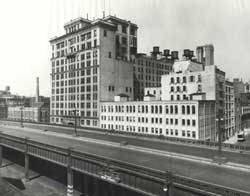Bell Labs' New York City building, in the mid-1930s. Courtesy: Lucent Technologies.

Bell Labs
Since the early 1900s Bell Telephone Laboratories, or Bell Labs, has been a major source of technological experimentation and change. Bell Labs has sponsored research far beyond the limits of its original focus, the telephone. From telephones to radar to computers, the scientists at Bell Labs have had a hand in the most important inventions of the 20th century.
The roots of Bell Labs lay in the American Telephone and Telegraph Company (AT&T), which became the parent organization of Bell Telephone Company and part of which evolved into today’s Lucent. Founded by Alexander Graham Bell in the 1870s, by 1910, AT&T had grown from a tiny firm to a large corporation with several subsidiaries, one of which was the Western Electric Company. Western Electric, the manufacturing branch of AT&T, made telephones, switchboards, and other types of equipment. Following in the footsteps of Thomas Edison’s famous research laboratory in New Jersey, Western Electric in 1911 created a special research department to bring together various experimental efforts aimed at improving telephone equipment, and to develop and patent new products to keep ahead of the competition. During the rest of the decade and into the late 1920s, Western Electric engineers developed the dial telephone system, automatic switchboards, the first electronic amplifiers (which made cross-country long-distance calling possible), and moved into entirely new areas like radio, phonograph records, and motion picture soundtracks.
By the early 1920s the research effort had grown so large—over 3600 employees by 1924—management decided to split it off into its own organization. This new company, owned entirely by AT&T, was called the Bell Telephone Laboratories. The existing research building in New York City was greatly enlarged that same year, and Bell Labs was on its way to becoming the world’s largest industrial research laboratory.
In the 1930s and through the end of World War II, Bell Labs continued to expand. The company established new research facilities in New Jersey, where open land was still plentiful and cheap. The huge resources of AT&T, which had a monopoly on telephone service, enabled Bell Labs to undertake fundamental research that had only loose ties to ordinary telephone service. In 1933, for example, Karl Jansky, working at the Holmdel, New Jersey facility, discovered radio astronomy. Another trend was closer cooperation with the military, which had begun during World War I, and which continued in the 1930s as Bell Labs began working on radar and military communication systems. When World War II came, Bell Labs invented or improved numerous military systems, such as the two-way radio, proximity fuses, semiconductor devices, radar, sonar, computers, the “bazooka,” and the first encrypted communications systems.












No comments:
Post a Comment